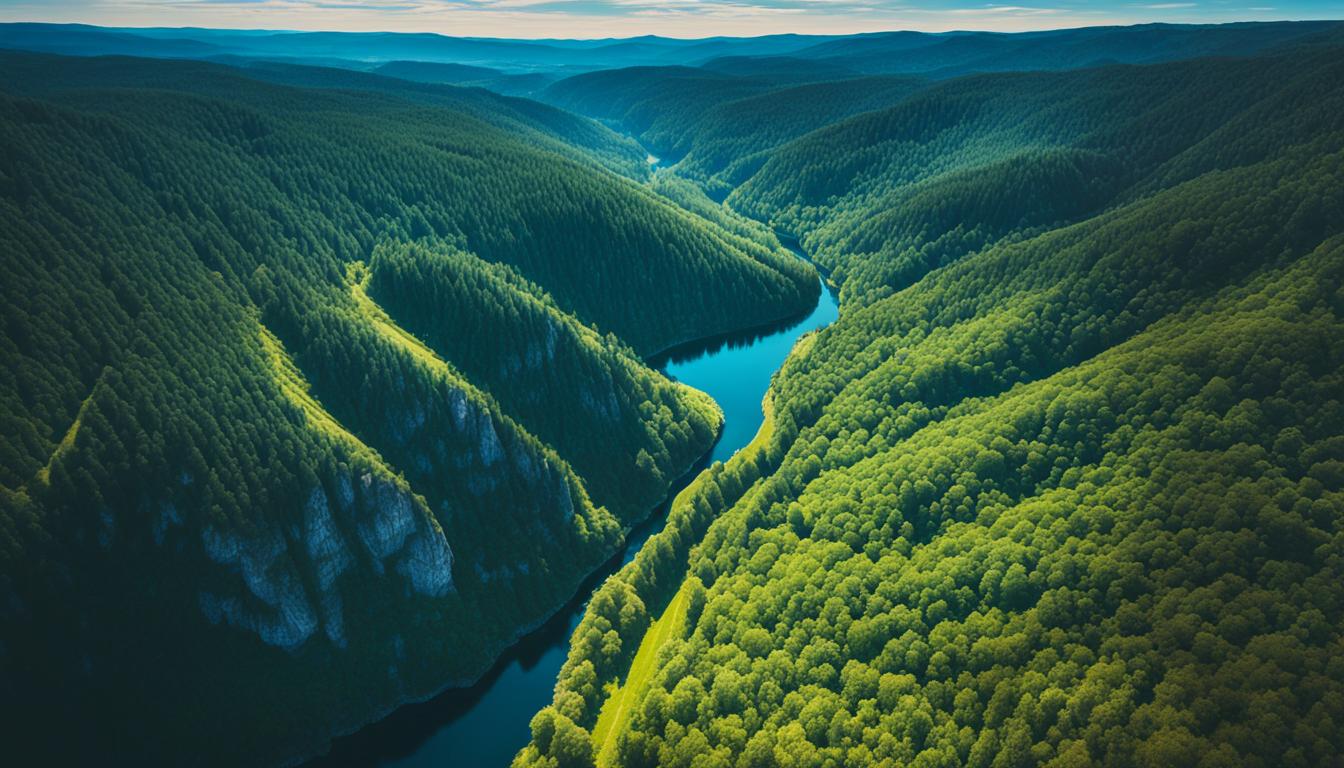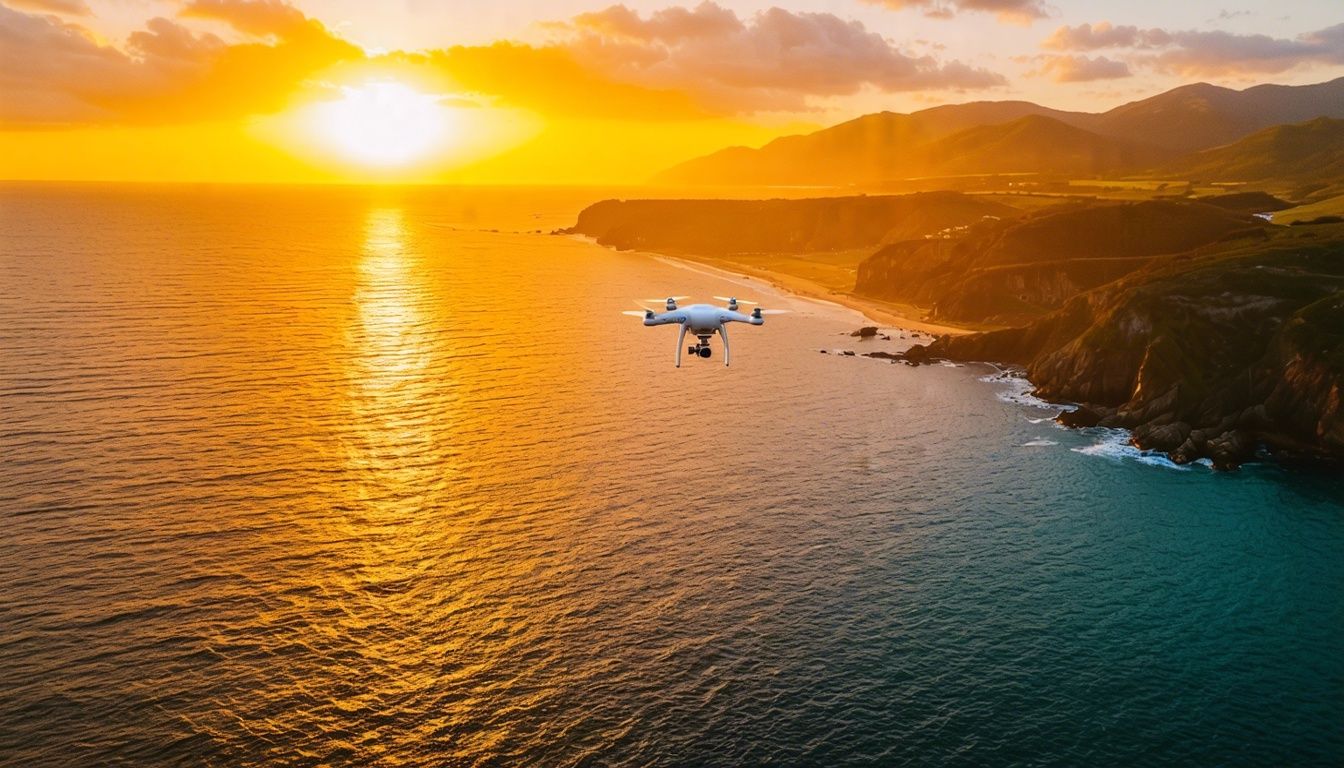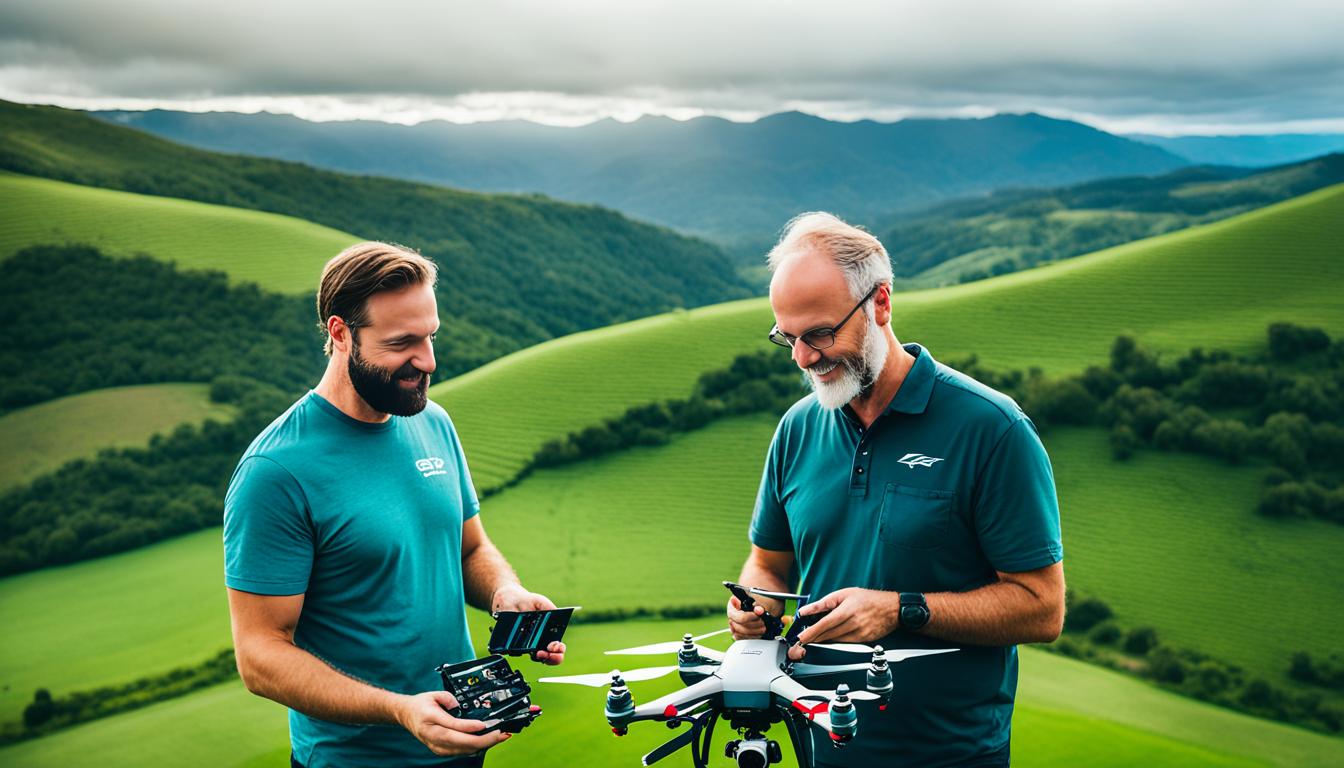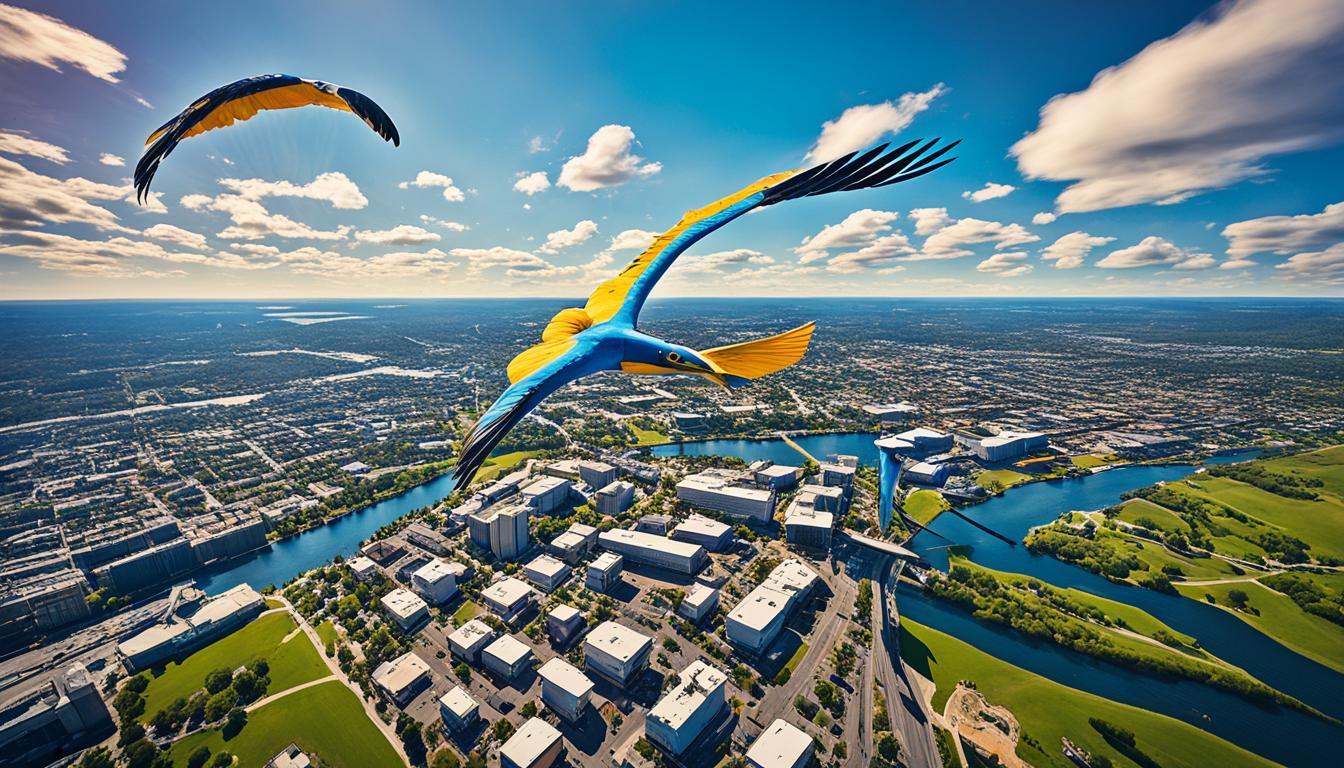Welcome to our guide on post-processing drone photos! If you’re an aspiring drone photographer or already have experience in capturing stunning aerial shots, this article is for you. We’ll be diving into the world of post-processing and exploring how it can take your drone photography to new heights.
Post-processing drone photos involves using photo editing techniques and tools to enhance your images, bringing out their full potential. Whether you’re looking to create breathtaking landscapes, showcase architectural marvels, or capture unique perspectives, post-processing can help you achieve the desired results.
With the right image enhancement techniques, you can refine colors, adjust lighting, sharpen details, and retouch any imperfections. This allows you to create compelling visuals that leave a lasting impression on your audience.
When it comes to post-processing drone photos, there are a plethora of editing software options available, tailored specifically for aerial photo editing. These tools offer a wide range of features and functionalities, enabling you to fine-tune your images with precision and ease.
Whether you’re a beginner or an advanced user, post-processing allows you to achieve the desired look and feel for your drone photos. You can experiment with different styles, enhance the clarity and sharpness of your images, and even create stunning panoramic shots by stitching multiple photos together.
Are you ready to take your drone photography to the next level? In the following sections, we’ll explore the basics of drone photography, provide in-flight techniques for capturing incredible shots, discuss post-processing techniques, delve into drone regulations and safety, and even explore how to transform your drone photos into works of art. Let’s get started!
Key Takeaways
- Post-processing is essential for enhancing drone photos and unlocking their full potential.
- Photo editing tools and techniques can help refine colors, adjust lighting, and sharpen details.
- There are specialized software options available for aerial photo editing.
- Post-processing allows you to experiment with different styles and create stunning panoramic shots.
- Stay tuned as we explore the fundamentals of drone photography, in-flight techniques, post-processing techniques, drone regulations, safety, and transforming drone photos into works of art.
Understanding the Basics of Drone Photography
Drone photography has revolutionized the way we capture aerial shots, providing stunning perspectives that were once only accessible to professional photographers. Whether you’re a beginner or an experienced photographer, understanding the basics of drone photography is essential to capturing breathtaking images from the sky.
When starting with drone photography, it’s important to choose the right drone for your needs. Different models offer varying features and capabilities, so consider factors such as camera quality, flight time, and stability to ensure you invest in a drone that meets your requirements.
Once you have your drone, familiarize yourself with the camera settings. Adjusting settings such as aperture, shutter speed, and ISO will allow you to have precise control over the exposure and capture stunning aerial photographs. Keep in mind that shooting in RAW format will give you more flexibility during post-processing.
Composition plays a vital role in capturing visually appealing drone photographs. Utilize techniques such as the rule of thirds, leading lines, and symmetrical compositions to create visually balanced and captivating images. Experiment with different angles and perspectives to unleash your creativity and capture unique aerial shots.
When capturing drone photographs, consider using ND filters to control the amount of light that enters the camera. These filters help maintain proper exposure and reduce overexposure, especially when shooting in bright sunlight. ND filters are essential tools for achieving optimal image quality.
While indulging in the art of drone photography, it’s essential to respect drone regulations and fly responsibly. Familiarize yourself with local laws and regulations governing drone usage, ensuring you follow the guidelines set by the authorities. By adhering to drone regulations, you can ensure the safety of others and maintain a positive image for the drone photography community.
Capturing the Perfect Shot
Mastering drone photography involves a combination of technical skills, artistic vision, and an understanding of your equipment. By selecting the right drone, mastering camera settings, employing composition techniques, and adhering to drone regulations, you can elevate your aerial photography to new heights.
Are you ready to take your drone photography skills to the next level? Stay tuned for the next section where we’ll discuss preparation and in-flight techniques for capturing stunning drone photos.
Preparation and In-Flight Techniques for Drone Photography
When it comes to capturing breathtaking aerial shots with your drone, careful preparation and effective in-flight techniques are key. In this section, we’ll explore the importance of flight planning, checking weather conditions, and adhering to FAA regulations. We’ll also delve into valuable tips for monitoring battery life, managing memory storage, and utilizing ND filters for optimal light control. Plus, we’ll share composition techniques like the rule of thirds, leading lines, and panning to help you capture stunning images.
Flight Planning and Weather Conditions
Before taking off, it’s vital to have a solid flight plan in place. Researching locations and understanding the surrounding environment will help you identify the best vantage points for aerial photography. Pay attention to any potential obstacles or restricted areas that may affect your flight. Additionally, always check weather conditions to ensure safe and optimal flying conditions. Unfavorable weather, such as strong winds or heavy rain, can compromise the quality of your photos and pose a risk to the drone’s stability.

FAA Regulations and Compliance
Operating your drone in compliance with FAA regulations is crucial for both safety and legal reasons. Familiarize yourself with the guidelines and restrictions outlined by the FAA, such as altitude limitations, airspace requirements, and drone registration. By understanding and adhering to these regulations, you can fly responsibly and avoid unintentionally endangering others or violating airspace restrictions.
Battery Life and Memory Management
Effective battery management is essential for uninterrupted flight sessions and capturing that perfect shot. Be mindful of your drone’s battery life and monitor it closely during flights. Plan your flight routes to allow ample time to return and land safely before the battery depletes. Additionally, pay attention to memory storage capacity. Large RAW files and high-resolution images can quickly fill up your memory card, so consider carrying spare cards or transferring files to a hard drive when necessary.
Utilizing ND Filters for Light Control
ND (Neutral Density) filters are valuable tools for controlling light exposure in drone photography. These filters reduce the amount of light entering the camera, allowing for longer shutter speeds and balanced exposures. By using ND filters, you can capture properly exposed images even in bright and harsh lighting conditions, resulting in enhanced image quality and dynamic range.
Composition Techniques: Rule of Thirds, Leading Lines, and Panning
Composition plays a crucial role in creating visually appealing and captivating drone photos. By employing composition techniques such as the rule of thirds, leading lines, and panning, you can add depth, balance, and movement to your aerial shots.
- The Rule of Thirds: Divide the frame into nine equal sections using imaginary lines. Positioning the main subject along these lines or at the intersection points creates a visually balanced composition.
- Leading Lines: Incorporate leading lines, such as roads, rivers, or paths, to guide the viewer’s eye and add depth to your images. These lines can create a sense of direction and perspective, making your photos more engaging.
- Panning: Experiment with panning techniques while capturing moving subjects. By tracking the subject’s movement with your drone’s camera, you can achieve a sharp subject against a blurred background, adding a sense of speed and dynamism to your shots.
By incorporating these preparation and in-flight techniques into your drone photography workflow, you’ll be well-equipped to capture stunning aerial images that truly stand out.
Post-Processing Techniques for Drone Photos
When it comes to drone photography, the magic happens not only in the sky but also during the post-processing stage. Harnessing the power of editing software and working with RAW format can take your aerial shots to new heights. In this section, we will explore the essential post-processing techniques that will elevate your drone photos and help you achieve that natural, professional look.
The Benefits of Editing Software
Editing software is a game-changer when it comes to enhancing drone photos. With a wide range of tools and features, you can make subtle or dramatic adjustments to your images, bringing out the best in every shot. Whether it’s tweaking the exposure, adjusting the colors, or fine-tuning the details, editing software allows you to express your creative vision and take full control of your drone photography.
Working with RAW Format
Shooting in RAW format gives you maximum flexibility during post-processing. Unlike JPEG, RAW files retain all the original data captured by the camera sensor, allowing for more precise adjustments and preserving the highest image quality. RAW format provides a wide dynamic range, giving you the freedom to recover highlights and shadows, and achieve stunning results without compromising details or colors.
Lighting Adjustments
Proper lighting is crucial for creating captivating drone photos. However, lighting conditions can be challenging to control while flying. That’s where post-processing comes in. By making lighting adjustments, such as increasing/decreasing exposure, modifying highlights and shadows, or balancing the overall tone, you can transform the mood and impact of your images, bringing out their full potential.
Horizon Straightening and Cropping
One common issue in drone photography is a crooked horizon. Thankfully, most editing software provides tools for straightening and leveling the horizon, ensuring that your shots appear level and professional. Additionally, cropping can help you enhance composition, eliminate distractions, and focus on the key elements of your aerial photos, resulting in visually pleasing images that tell a compelling story.
Utilizing Lens Filters
Lens filters are indispensable accessories when it comes to drone photography. They can enhance colors, reduce glare, and manage light in different environments. During post-processing, you can further optimize the use of lens filters by adjusting the color temperature, saturation, or contrast to achieve a harmonious and natural look, highlighting the unique beauty of your aerial shots.
To give you a visual idea of the impact of post-processing techniques, take a look at the example below:
“Post-processing allows us to turn an ordinary aerial shot into a breathtaking masterpiece. With the right editing software, a keen eye for detail, and a dash of creativity, we can unlock the true potential of our drone photos and create captivating visuals that leave a lasting impression.”
By adopting these post-processing techniques, you can take your drone photography to the next level, producing stunning images that captivate viewers and truly stand out. In the next section, we will delve into the essential information on drone regulations, safety practices, and the equipment you need to navigate the world of drone photography seamlessly.
Drone Regulations, Safety, and Equipment
When it comes to drone photography, understanding and adhering to the necessary regulations is crucial for a safe and enjoyable experience. The Federal Aviation Administration (FAA) has established guidelines to ensure the responsible operation of drones in the airspace.
One of the key requirements is drone registration. Before taking to the skies, all drone owners must register their aircraft with the FAA. This process helps to promote accountability and the responsible use of drones.
Additionally, it is essential to familiarize yourself with the airspace requirements in your area. Different locations may have specific restrictions or no-fly zones that drone operators must respect. Always check for any airspace restrictions, such as proximity to airports or other sensitive areas, before flying your drone.
To enhance your drone photography experience, consider investing in essential accessories. These accessories can help improve the performance and capabilities of your drone. Some popular accessories include extra batteries for extended flight time, propeller guards for added safety, and ND filters to control light and reduce glare in your aerial shots.
Maintenance and Safe Flying Practices
Proper maintenance of your drone is key to ensuring its optimal performance and longevity. Regularly inspect your drone for any signs of damage or wear and follow the manufacturer’s recommended maintenance procedures. By taking care of your equipment, you can prevent accidents and maintain the quality of your aerial shots.
When operating your drone, it is vital to practice safe flying techniques. Always fly your drone within your line of sight and away from crowds, buildings, and other obstacles. Maintain a safe distance from people and respect their privacy. Be aware of weather conditions and avoid flying in strong winds or adverse weather conditions that may jeopardize the safety of your drone and others.
By following the FAA guidelines, registering your drone, and practicing safe flying practices, you can enjoy the incredible world of drone photography while respecting the regulations and ensuring the safety of yourself and others.
Drone Accessories Comparison
| Drone Accessory | Description | Benefits |
|---|---|---|
| Extra Batteries | Additional batteries for extended flight time | – Capture more footage without interruption – Ideal for longer photo sessions or video shoots |
| Propeller Guards | Protective guards for propellers | – Minimize damage in case of collision – Enhance safety when flying near people or objects |
| ND Filters | Neutral Density (ND) filters to control light | – Reduce glare and overexposure in aerial shots – Enhance image quality and color accuracy |
Transforming Drone Photos into Works of Art
At [Your Company Name], we understand the desire to turn your breathtaking drone photos into stunning works of art. With our premium print services, you can bring your aerial shots to life and showcase them in the most captivating and visually appealing way.
Canvas Printing: Preserving the Beauty
Canvas printing is an excellent choice for transforming your drone photos into timeless pieces of art. The texture and depth of canvas add a unique dimension to your images, giving them a painterly look and feel.
Canvas prints offer durability and longevity, ensuring that your aerial photos will stand the test of time. They are perfect for displaying in your home, office, or gallery, adding a touch of elegance and sophistication to any space.
Acrylic Printing: Captivating Clarity
For those seeking to enhance the vibrancy and clarity of their drone photos, acrylic printing is the perfect choice. This modern printing technique involves mounting your image onto a high-quality acrylic panel, creating a stunning visual impact.
The transparency of the acrylic material gives your photos a sleek and glossy appearance, while the vibrant colors and sharp details make your images truly come alive. Acrylic prints are ideal for modern and contemporary settings, adding a touch of sophistication and elegance to any room.
Frame Choices: Enhancing the Aesthetic
Choosing the right frame is crucial in enhancing the aesthetic appeal of your drone photos. At [Your Company Name], we offer a wide variety of frame choices to complement your aerial shots and suit your personal style.
If you prefer a classic and timeless look, wood frames are an excellent option. They add warmth and depth to your images, creating a traditional yet elegant display.
For a more modern and sleek approach, metal frames are a popular choice. The clean lines and minimalist design of metal frames beautifully complement the contemporary feel of aerial photos, adding a touch of sophistication to any space.
Whether you opt for wood frames or metal frames, our selection ensures that your drone photos are presented in the most appealing and complementary way.
Transform your drone photos into works of art with our premium print services. Choose the printing option that best suits your style and showcase your aerial shots in an enchanting and visually captivating manner. From canvas and acrylic printing to selecting the perfect frame, our expert team is here to bring your vision to life.

Comparison of Printing Options and Frames
| Printing Options | Features |
|---|---|
| Canvas Printing | – Texture and depth |
| – Painterly look and feel | |
| Acrylic Printing | – Vibrant colors and sharp details |
| – Sleek and glossy appearance | |
| Frame Choices | – Wood frames |
| – Classic and timeless look | |
| – Metal frames | |
| – Modern and sleek design |
Conclusion
In conclusion, drone photography opens up a world of possibilities for capturing stunning aerial shots. However, to truly elevate these images, post-processing is essential. By using image enhancement techniques and editing tools, we can bring out the full potential of our drone photos.
Moreover, it is crucial to understand and adhere to drone regulations to ensure safe and responsible flying. Familiarizing ourselves with FAA guidelines, registering our drones, and flying within airspace requirements are essential steps in this process. By following these regulations, we can not only protect ourselves and others but also enjoy a worry-free drone photography experience.
Once we have perfected our post-processing skills and taken stunning aerial shots, why not showcase them as works of art? Print services offer various options such as canvas, acrylic, and metal prints, allowing us to display our drone photos in a beautiful and professional manner. With the right frame choices, our aerial shots can become captivating pieces that add a touch of elegance to any space.
In summary, by combining the power of drone photography, post-processing techniques, and adherence to drone regulations, we can create breathtaking aerial shots and transform them into captivating works of art. Whether it’s for personal enjoyment or to share with others, the possibilities are limitless.
FAQ
Why is post-processing important for drone photos?
Post-processing allows you to enhance the quality and visual appeal of your drone photos by making various adjustments to the image, such as lighting, color correction, and cropping. It helps bring out the full potential of your aerial shots.
Should I shoot in RAW format for drone photography?
Yes, shooting in RAW format is highly recommended for drone photography. RAW files contain uncompressed and unprocessed image data, providing you with greater flexibility and control during the editing process.
What are some essential editing tools and techniques for drone photos?
Some popular drone photo editing tools include Adobe Lightroom, Capture One, and Luminar. Common techniques used for enhancing drone photos include adjusting lighting and contrast, straightening horizons, cropping for composition, and applying lens filters.
How can I make my drone photos look natural and realistic after editing?
To maintain a natural and realistic look in your edited drone photos, it is important to strike a balance between enhancing the image and avoiding excessive edits. Avoid over-saturating colors or over-sharpening the image, aiming for a result that reflects the original beauty of the scene.
What are the FAA guidelines for safe and responsible drone flying?
The Federal Aviation Administration (FAA) provides guidelines for drone flying, including requirements for drone registration, flying within visual line of sight, and avoiding restricted areas such as airports. It is crucial to familiarize yourself with these regulations and adhere to them for safe and legal drone operations.
What are some recommended print options for showcasing drone photos?
Canvas and acrylic printing are popular options for showcasing drone photos. Canvas gives a traditional and artistic feel to the photo, while acrylic prints offer a more modern and vibrant look. Metal prints are also an option for vibrant colors and frameless display.
How Can I Use Post-Processing Techniques to Enhance Wildlife Drone Photography?
Utilize various post-processing techniques to enhance the quality of wildlife photography captured by drones. Adjust exposure levels, sharpen details, and apply selective color adjustments to make the images pop. Experiment with different filters and overlays to bring out the true beauty of wildlife captured from above with wildlife photography drones.




